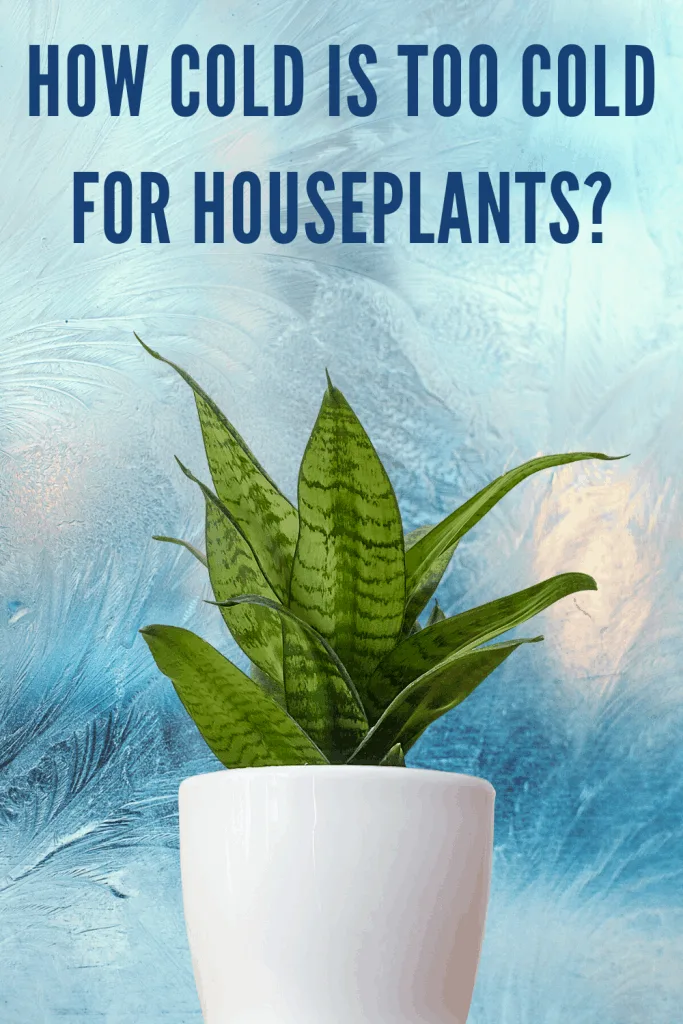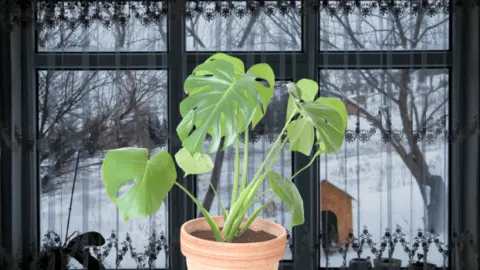Different houseplants, different needs.
While some houseplants are not afraid of the cold, others can’t cope with cold temperatures at all.
So, this begs the question:

Table of Contents
How old is too cold for houseplants?
Temperatures below 50°F (10°C) are generally too cold for most houseplants. Desert plants, tropical plants, blooming plants, ferns, ficus, and palms have varied needs; it’s advised to move them indoors before the first frost to prevent cold damage.
Different houseplants, different needs
When having a look at the different plants that people keep in their homes, it quickly becomes evident that the range of plants that people grow indoors is very wide.
Some people are in love with tropical plants such as the Ponytail palm, Alocasia Amazonica, Dieffenbachia, and numerous species of Philodendron.
Yet others prefer to grow desert plants as houseplants, such as cacti & succulents.
Now, the needs of tropical plants and desert plants are obviously pretty different.
This is equally reflected in the ideal temperatures that these individuals should be grown.
What might be too cold for one houseplant might be ideal for others.
Now that we have this kind of background knowledge let us have a look at the temperatures that different houseplants can tolerate:
| Plant Type | Cold Tolerance (Lowest tolerable temperature) | Preferred Temperature Range | Additional Notes | |
|---|---|---|---|---|
| Tropical Plants | 50°F (10°C) | 64°F to 75°F (18°C to 24°C) | Stunted growth below 50°F. | |
| Desert Plants | 40°F (4°C) | Average to warmer room temperatures | Typically cold-resistant. | |
| Blooming Plants | 50°F (10°C) | Average room temperatures | ||
| Ferns | 50°F (10°C) | Average to cool room temperatures | ||
| Ficus Plants | 50°F (10°C) | 65°F to 80°F (18°C to 27°C) | Certain species may tolerate slightly cooler temperatures, but 50°F is a safe general threshold. | |
| Palms | Growth affected below 64°F (18°C) | Warm temperatures | Growth slows significantly below 64°F. |
How cold is too cold for blooming houseplants?
Many blooming houseplants such as Begonias, Bromeliads, Tillandsias, and many others are best grown in average room temperatures.
These kinds of houseplants tend to like it a little bit warmer during summer (average room temperature ranging from 65 to 75 Fahrenheit is best for most begonias) and then like a cool rest during winter (in the 60 F/16 degrees Celcius range).
Blooming houseplants generally don’t tolerate cool temperatures. Most can’t handle temperatures below 10 degrees at all.
Plant damage might already happen with temperatures below 13 degrees (for instance, with begonias).
A few might be able to tolerate chilling temperatures temporarily, but that doesn’t mean that they really enjoy it!
How cold is too cold for ferns?
It’s always interesting to talk about ferns. And to many, ferns are known to be little divas that are very hard to take care of.
But does this also hold true when it comes to the ideal temperature range for ferns?
Well, ferns are tropical plants. So they must like the heat, right?
Not exactly. They actually do really well in average or even cool room temperatures. This especially holds true for indoor ferns.
During the day, ferns like it a little bit hotter (70 to 80 Fahrenheit/ 21 to 27 degrees Celcius) than during the night (60 to 65 Fahrenheit /16 to 18 degrees Celcius)
That said, they do tolerate slight chillings during the night, and as long as you don’t go lower than 50 Fahrenheit (10 degrees Celcius), you are usually safe.
So, when grown indoors, temperature requirements are probably not all that challenging to meet.
But ferns certainly pose other difficulties when grown indoors as houseplants. Read more on particularly fussy ferns here:
But not all ferns are particularly fussy plants.
If you are on the lookout for an easier fern to take care of, try the Kangaroo Paw Fern.
How cold is too cold for Ficus plants?
Ficus plants are popular foliage plants that are often grown indoors.
The genus Ficus actually includes different types of plants, such as bonsais, ficus trees, and even trailing types, such as the Ficus pumila.
Most ficus plants thrive in a wide range of temperatures, most being comfortable in average to warm temperatures (65 to 80 Fahrenheit / 18 to 27 Celcius).
The creeping fig, Ficus pumila, is somewhat more hardy in this regard, though.
Ficus pumila can cope with temperatures to freezing.
One thing to note in general about ficus plants is that they are very susceptible to change. This obviously includes changes in temperature.
That said, once you found the perfect spot for your ficus plant, it is best not to move it anymore, as it will need lots of time to adapt to a new environment.
How cold is too cold for Monsteras?
We are big Monstera fans.
In fact, you’ll find plant care articles for a wide range of Monsteras right here on Plantophiles:
- Monstera Standleyana Care
- Monstera Epipremnoides
- Monstera Siltepecana Care
- Variegated Monstera Deliciosa
- Monstera Adansonii
But let’s now get back to our original question. So, please tell me, how cold is too cold for Monstera plants?
Providing Monsteras with the right temperature is not all that difficult.
Monsteras generally do well in average room temps ranging from 64 Fahrenheit to 75 Fahrenheit (18 to 24 degrees Celcius.
That said, they certainly don’t like extreme temperatures, be it extremely cold temperatures or extremely warm temperatures.
Most Monsteras can withstand cold temperatures as low as 50 Fahrenheit (10 degrees Celcius).
Cold temperatures are, however, not ideal for monsteras, as they will result in stunted growth.
This is not only true for Monsteras but also for many other houseplants.
Stunted growth is often also a result of a lack of sunlight.
How cold is too cold for palms?
Palms are tropical plants. So, it doesn’t come as a surprise that they can deal with very warm temperatures as high as about 100 Fahrenheit. But how well do palms tolerate cold weather?
Well, palms can cope with colder temperatures as well, but if the temperatures drop below 64 Fahrenheit (18 degrees Celcius), the growth of your palm will be severely impacted (= will grow much slower).
While some chilling is not detrimental for most palms, they definitely prefer warmer temperatures.
Are you planning to extend your urban jungle with some beautiful indoor palms?
Read our in-depth guide on indoor palm care to get more familiar with palms that do great indoors!
How cold is too cold for Philodendrons?
That said, philodendrons tolerate changes in temperature and location pretty well. Other houseplants are not very forgiving in this regard (Crotons come to mind).
So what kind of temperatures do philodendrons like best?
Average to warm (room) temperatures sit very well with Philodendrons (60 to 80 Fahrenheit / 16 to 27 degrees Celcius).
As far as cold temperatures go, Philodendrons are not exactly forgiving.
Does this come as a surprise?
Not really. As philodendrons are tropical plants, they generally don’t tolerate cold temperatures.
A freeze is even likely to kill your Philodendron.
But not only cold temperatures can put your Philodendron at risk. Learn what else is important whenever Philodendron care is involved:
Here are some of our favorite Philodendron species and how to take care of them:
- Philodendron Birkin
- Philodendron Gloriosum
- Heartleaf Philodendron
- Philodendron Spiritus Sancti
- Philodendron Selloum
How cold is too cold for succulents?
So what about succulents? Are they doing OK in cold weather?
In fact, as desert-dwellers, succulents are indeed pretty cold-resistant.
As desert plants, they can handle both cold nights and very warm temperatures during the day.
Ok, great. But could you please get a little bit more specific here?
Many succulents can tolerate temperatures as low as 40 degrees Fahrenheit (about 4 degrees Celcius).
The symptoms of cold weather shocked plants
It certainly helps to inform yourself about the ideal conditions in terms of temperature regarding your favorite plants.
But not only the internet or maybe some smart books about indoor plants can give you some hints on the question “How cold is too cold for houseplants.”
So, who else can be of help to solve this mystery?
Well, your plant!
Because whenever cold damage happens, your plants will make sure to let you know. So let us have a look at the most common symptoms indicating cold damage:
- Droopy leaves
- Leaf discoloration
- Plant wilting
- Blackened foliage
- Loose root ball
Now, while cold damage is to be taken seriously, it doesn’t necessarily mean that your plants are going to die.
As far as revival measures go, you need to err on the side of caution.
For instance, immediate pruning is usually not a good idea, as this will cause further distress for your plant.
Also, immediately fertilizing your plant after cold damage has been dedicated is a very bad idea.
As far as the temperature goes, it might sound logical that you would want to move the cold-damaged plants to another, warmer location.
This is not necessarily a bad idea. Just keep in mind that you need to give your plant some time to adjust to the new surroundings, so if you are moving your plant to a new location, do this gradually and not straight from place A to place B.
Many houseplants are very susceptible to changes in temperature; for cold-damaged plants, this is even more true.

Daniel has been a plant enthusiast for over 20 years. He owns hundreds of houseplants and prepares for the chili growing seasons yearly with great anticipation. His favorite plants are plant species in the Araceae family, such as Monstera, Philodendron, and Anthurium. He also loves gardening and is growing hot peppers, tomatoes, and many more vegetables.


